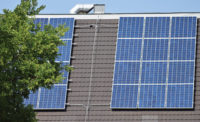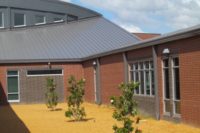Nova Place is a 100-million-dollar urban redevelopment of the former Allegheny Center Mall into an innovative technology campus in Pittsburgh’s historic North Side. Owned and operated by Faros Property Management, it is one of the nation’s largest urban redevelopment projects encompassing 30 acres of mixed-use space, including 1.5 million square feet of office space. The facility is Pittsburgh’s largest corporate technology campus with common areas, collaborative workspaces, restaurants, a fitness and conference center and a 3,000-car parking garage with bike storage.
As part of the multi-year project, L&M Roofing Associates, LLC, of Carnegie, PA, was hired to replace about 65,000 square feet of old rubber roofing on the Nova Place Concourse. L&M Roofing is a leading commercial roofing contractor serving commercial and industrial clients in Western Pennsylvania including Pittsburgh, Washington, and Erie. The company has over 50 years of experience and focuses on single-ply, asphalt, and standing seam metal roof systems and repairs.
The project involved removing the old Inverted Roof Membrane Assembly (IRMA) and replacing it with a gray Carlisle Sure-Weld TPO roof. The original assembly included 1.5-inches of polyisocyanurate insulation loose laid on the deck, the 60-mil EPDM membrane, another layer of 1.5-inch blue board insulation, and a black weed control fabric, all topped and secured in place. The material was removed from the roof through a custom-built trash chute that was designed specifically for the project, and large enough to handle full sheets of blue board insulation, which was recycled.
“One of our first big challenges on this project was removing the old EPDM roof and ballast,” said Jim Melnik, owner of L&M Roofing. “Normally, vacuuming off the ballast is no problem; however, the IRMA system included a weed-control fabric installed under the ballast, which kept getting caught in and clogging up the vacuum. We had to bring in some extra labor to separate the fabric from the ballast to prevent this from happening. In addition, there were several spots where the old insulation really stuck to the deck, so we had to spend some extra time scraping and cleaning those areas well.”
In addition, there were two rows of 2’ x 2’ pavers around the entire perimeter of the roof. The pavers were banded together with 3” flat steel straps that had to be cut apart. Half of the pavers were discarded, but the other half were stored on site for reinstallation around the perimeter of the roof later.
After vacuuming the gravel off the roof, L&M Roofing loaded the roof with seven truckloads of new polyisocyanurate insulation and two truckloads of membrane and accessories for the new roof assembly, which consisted of the 60-mil gray Carlisle Sure-Weld TPO membrane and two layers of 2.6-inch-thick polyiso insulation that provided an R-30 rating.
After clearing a large section of the roof of ballast and the old roofing materials and ensuring that the deck was smooth and dry, the crew installed the 4’ x 4’ sheets of polyisocyanurate using Carlisle Flexible FASTä, a two-component, low-rise polyurethane adhesive.
“We really like the Flexible FAST Dual Tank Adhesive for securing insulation,” said Melnik. “It’s the ideal adhesive for securing polyiso to concrete decks, and it’s easy to move around on the roof using a dolly. It installs at least twice as fast as rolling out the adhesive, provides great coverage rates, and there’s no odor, so everyone on the crew loves it. We had one guy spraying and one guy dropping in the installation and had great productivity.”
The crew from L&M Roofing was able to install 15 squares of insulation per day, with 6” on-center (OC) bead spacing around the perimeter of the roof, and 12” OC spacing in the field of the roof. The insulation was staggered to prevent air leakage, and both layers were secured with the Flexible FAST Adhesive.
“The section of roof we were hired to work on had a low parapet wall around the entire perimeter,” said Melnik. “The crew installed a new nailer on the top of the parapet, which was not only necessary but also helps to ensure that the edge metal is as secure as possible. But after adding the two new layers of insulation to the deck, the parapet wall with the new nailer was only about 2.5” tall.”
To address the short parapet wall, L&M installed a custom-tapered insulation cant which allowed a smooth transition from the top of the insulation layer to the top of the parapet. This enabled the crew of 15 to easily install the TPO membrane up and over the edge. The membrane was then terminated with Metal-Era’s Anchor-Tite Fascia System, which is ANSI/SPRI/FM 4435/ES-1 tested and Factory Mutual approved for wind uplift protection. The fascia system includes an extruded aluminum water-dam cleat, which was secured through the face of the nailer and topped with an .040” aluminum cover that was 8.5” high.
“The custom cant was a real time saver for us,” said Melnik. “More importantly, it also eliminated the time, labor, and material costs associated with installing about 1,500 linear feet of fasteners and plates around the perimeter and installing the membrane up and over the parapet.”
Another challenge for the roofing team was cleaning and revamping nearly 30 existing drains and adding another 14 new drains to the roof.
“The drains were a big challenge, that took quite a bit of time,” said Melnik. “We had five guys working for three days to address all the drains, and we had to work closely with the Faros Construction team to coordinate all the work with the plumbing contractor. But it was the ideal scenario for installing new construction drains since the space below, which will eventually become a robotics laboratory, was vacant and being built out at the time.”
For the new drains, the team from L&M Roofing cut the structural concrete deck and installed the drains but left them covered with the TPO membrane until they were connected to the existing system. Once that was done, L&M Roofing cut out the membrane and opened the drains.
While the structural concrete roof deck was relatively flat, the building was originally designed for further expansion and to support two additional floors. As a result, there were 94 concrete footings on the concrete deck designed to accommodate new steel or concrete pillars. Most of them, 82 in fact, measured two feet square, while the remaining 12 down the center of the roof were each 2’ x 4’ in size.
The 10’-wide TPO membrane was installed using Carlisle’s CAV-GRIPâ III contact adhesive. In addition to flashing all the concrete footings on the deck, there were also a few other penetrations such as air vents that needed to be addressed. Otherwise, the membrane was rolled out and fused together with an automatic welder.
“We absolutely love the Carlisle CAV-GRIP, and believe we were one of the first companies to embrace it,” said Melnik. “Spraying the adhesive is much faster and cleaner than using hand rollers. I’m sure we’ll never go back!”
“There were certainly several things about this roof that made the project more challenging than a wide-open 650-square job,” said Melnik. “Our guys did a great job handling all of the issues, identifying and implementing good solutions to the problems, and nicely completing all of the small details, which is a hallmark of our company and something of which I am very proud.”
As a testament to the great work by L&M Roofing, the company has already started on another 85,000-square-foot section of the roof.




